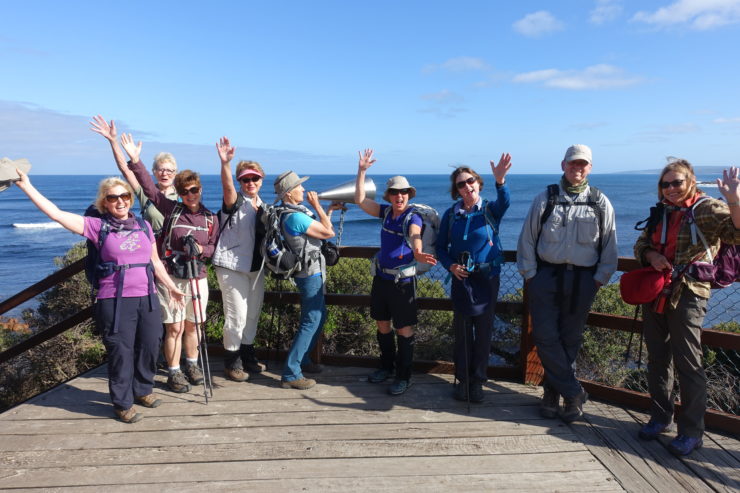How to be a good hiking citizen

How to be a good hiking citizen
Posted on
The internet is overflowing with articles about hiking “etiquette”. Lists of rules about which side of the track you should walk on, or who should yield when hikers meet on a hill. To me, these rules are generally pretty obvious, and most are unnecessary if you just communicate with other people on the trail.
This is not one of those articles. Being a good hiking citizen goes deeper than a basic set of rules and these ideas might be a bit less obvious to new hikers. They’re about making a real contribution to the hiking community and the wild places we enjoy.
Communicate with fellow hikers
Since I’ve already mentioned communication, we’ll start here. This is why we don’t need the rule about who should yield to whom on hilly trails. Believe it or not, when we come across each other in this situation we can just talk rather than following some arbitrary rule. Maybe I’d rather be the one to yield, regardless of what the rules say, because I’m in desperate need of an excuse to rest.
While I acknowledge that some people (solo female hikers in particular) might feel uncertain about chatting with strangers on the trail, I’m not talking about telling each other your life story. A passing “hello”, an “after you”, or a quick warning about a hazard or unclear trail intersection ahead is all that’s necessary.
Aside from making your hike more pleasant, communicating with fellow hikers can increase your safety. The information they provide might save you from getting lost, or you might learn that your intended trail is impassable, and you need to turn back. In the worst-case scenario, they might be the last people who saw you when you find yourself in need of rescue and could provide essential information to your rescuers.
Help keep marked trails clear
Sometimes when you’re following a trail that’s become unclear due to overgrowth, storm damage or flooding, you’ll find rock cairns or carefully placed fallen trees that help hikers find their way. If they’re done in a low impact way, these can be a great help to fellow hikers.
You can do your part by adding to them if they’re not clear enough, fixing them up if they’ve moved, or even creating one if you think it’s absolutely necessary. Keeping the marker low impact is important, though. Don’t damage any plants or use anything non-biodegradable to create them.
It’s also important that you only make them if you’re on a trail. There’s no need for them in off-track areas since anyone hiking there should be equipped to navigate without your assistance. Adding markers here would only be concentrating the hiker traffic and the impact that traffic will have on the landscape.
Think about your potential rescuers
I try to approach my decision making when I’m in the bush with a bit of empathy for the people who might potentially become my rescuers if I do something stupid.
A major example at the moment is the trend of ignoring common sense and taking dumb risks just to get the perfect photo for Instagram or Facebook. This has led to many severe injuries and deaths all over the world. Show any of these photos to a local rescuer and they’ll probably have at least one story for you about another photo attempt that went wrong at the exact location.
You may be willing to risk your own life, but think about the rescuer who will have to risk their own life to save you (or retrieve your body) if you fall.
Leave no trace
The “Leave no trace” initiative are a set of principles that, when followed, will ensure that you have minimal impact on our wild places. A good summary is “take only photos, leave only footprints.”
My view has always been that the wilderness is there for us to enjoy respectfully. We can help our parks just by visiting them, since visitors provide economic and social reasons for governments to protect them. We just need to make sure we look after them while we’re there.
When we see others on the trail who aren’t respecting the natural environment it can be tempting to just let it go. This is totally reasonable under some circumstances. Self preservation, especially when you’re miles from help, is everything. Obviously, you should use your best judgement and only say something if you feel safe to do so. If you see someone drop their lunch wrapper or flick their cigarette butt, you might be able to find a way to approach them without being confrontational and just have a chat about it. If you’re not comfortable doing so, this last tip is for you.
Pack it out
Hopefully, you don’t need to be told to bring along a rubbish bag for any food waste or packaging that you and your hiking buddies create. I like to bring a big bag and pick up other people’s rubbish that I find on the trail.
This requires so little effort, and there’s almost no satisfaction greater than knowing we’ve left a place cleaner than we found it. Being a good hiking citizen is kind of the same. It requires nothing but a little effort and some basic knowledge and respect, and makes the hiking trail a better place to be for everyone.
-Neil Fahey
Guest Blogger



